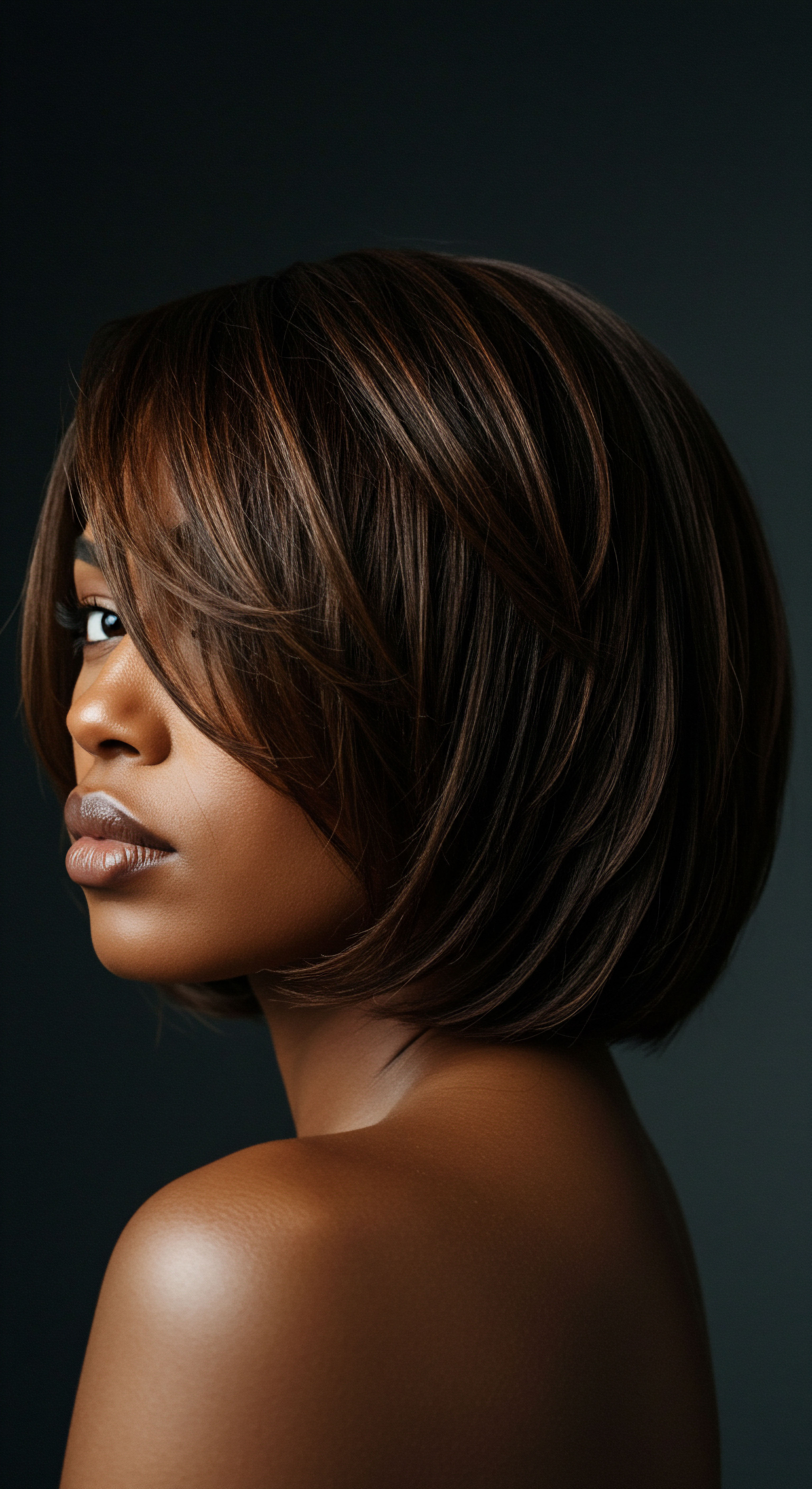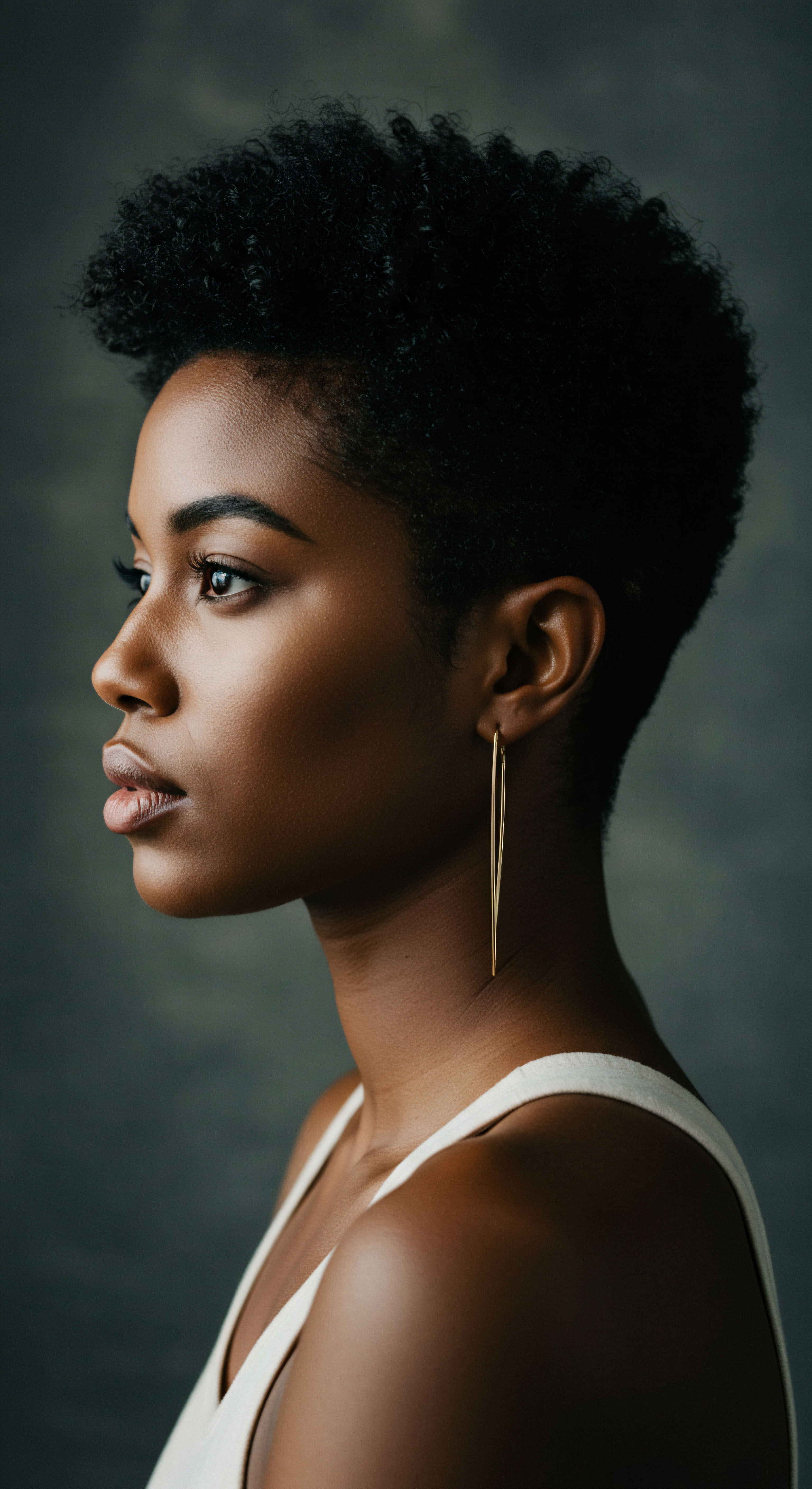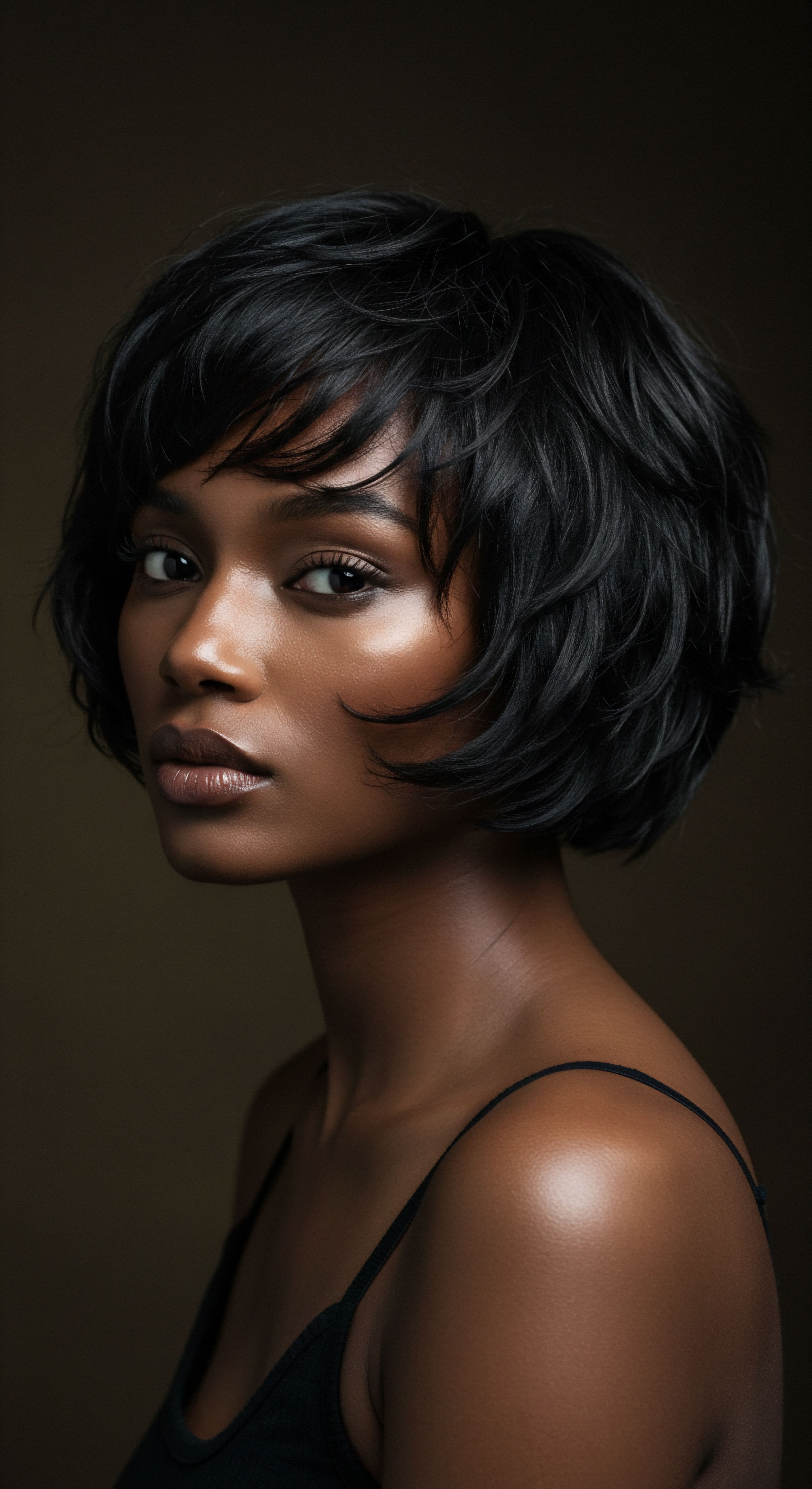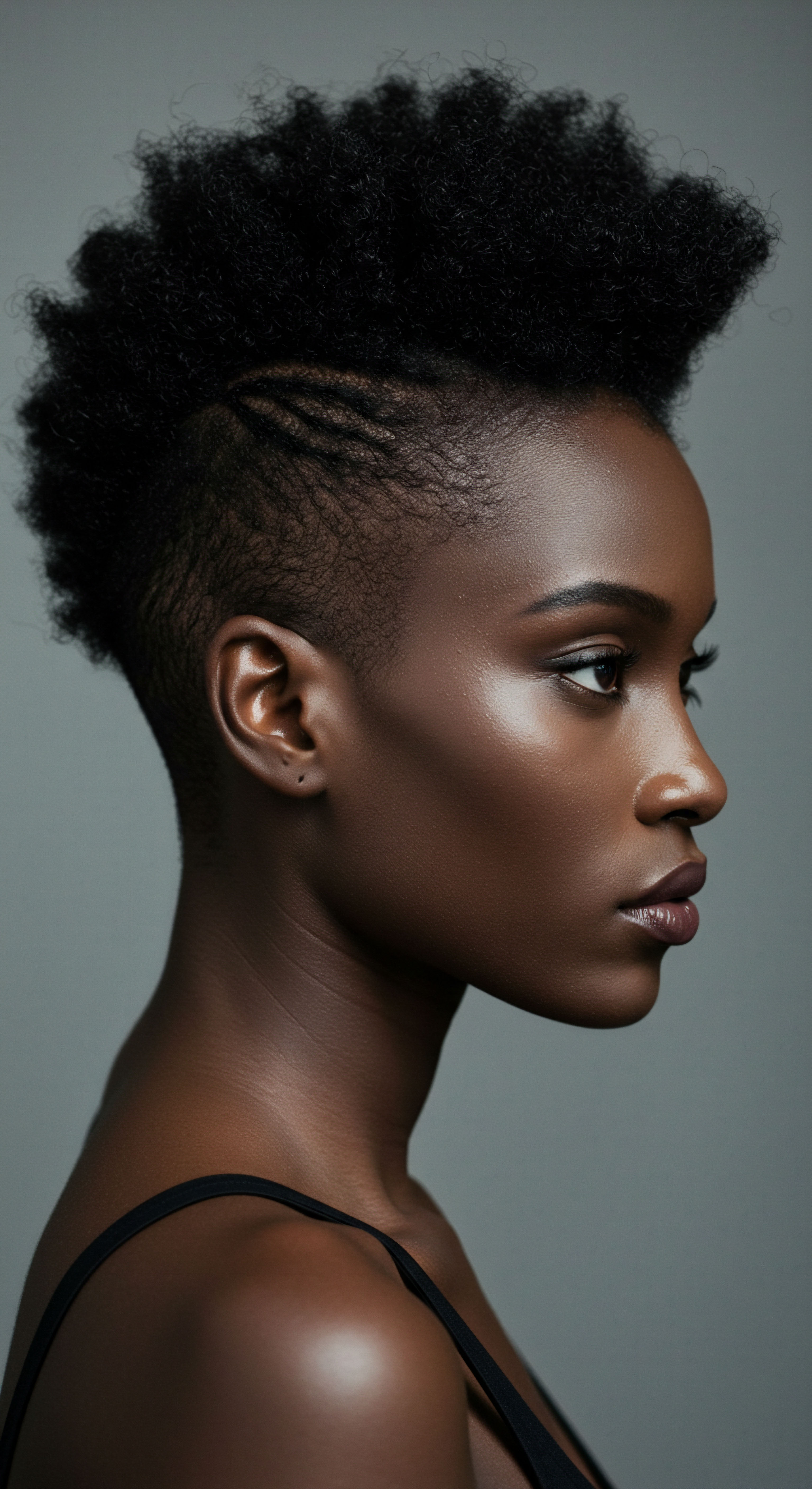
Fundamentals
The curl pattern, at its most straightforward explanation, refers to the natural shape and configuration of a hair strand as it emerges from the scalp. Imagine a delicate spring or a gentle wave; this inherent formation defines a hair’s curl pattern. For those new to the expansive world of textured hair, particularly within Black and mixed-race communities, understanding this basic concept unveils a profound pathway to authentic care. It’s a foundational element, guiding us toward appreciating the unique qualities each strand possesses.
Hair’s structure is determined by the shape of its follicle. A round follicle yields straight hair, while an oval or hook-shaped follicle creates varying degrees of curl, from subtle waves to tight coils. This intrinsic characteristic, largely determined by genetics, shapes how light reflects off the hair, how moisture interacts with it, and even how it feels to the touch. Recognizing this inherent form is the initial step in truly listening to what your hair needs.
Understanding curl pattern provides the initial compass for navigating the unique world of textured hair care.

The Genesis of Form ❉ Follicle Shape and Genetic Blueprint
Every individual hair strand begins its journey within a tiny pocket in the scalp, known as the hair follicle. The precise geometry of this follicle dictates the emerging strand’s shape. A perfectly circular follicle gives rise to straight hair, smooth and without bends. As the follicle gradually shifts to an oval or even a flattened, ribbon-like shape, the hair strand develops a curvature, resulting in waves, curls, or coils.
This fascinating biological process is largely pre-determined by one’s genetic heritage. Genetic variations, common across diverse populations, are intrinsically linked to the differences observed in hair texture. For instance, research indicates that African hair is almost invariably curly, often associated with distinctively curved hair follicles. This genetic blueprint is a silent storyteller, revealing tales of ancestry and adaptation within each strand.
Beyond the follicle’s shape, the distribution of proteins and pigments within the hair shaft itself contributes to its overall appearance and texture. These microscopic variations influence the strand’s ability to bend, coil, or wave. Hair, as a complex biocomposite system, primarily consists of keratin proteins, which respond to external stimuli. Therefore, the intrinsic structure, guided by genetic information, lays the groundwork for how hair behaves, absorbs moisture, and responds to various environmental factors.

Why This Meaning Matters for Textured Hair
For individuals with textured hair, especially those within Black and mixed-race communities, the meaning of curl pattern extends beyond mere aesthetics. It represents a fundamental aspect of hair care, influencing everything from product selection to styling techniques. Coily and curly hair types, due to their intricate structure, often require more specialized attention regarding moisture retention and protective styling.
Understanding the specific needs dictated by one’s curl pattern becomes a practice of gentle wisdom, ensuring strands receive the bespoke care they deserve. Without this foundational understanding, hair care can become a frustrating cycle of trial and error, rather than a serene journey of nourishment.

Intermediate
Moving beyond the foundational definition, the curl pattern’s significance deepens, becoming a practical guide for daily and weekly hair care rituals, particularly for textured hair. This intermediate understanding involves discerning the subtle distinctions within curl patterns and recognizing their direct influence on a hair strand’s behavior. It involves comprehending how the unique morphology of a curl impacts moisture absorption, susceptibility to tangles, and its natural elasticity. For those immersed in the daily rhythm of caring for Black or mixed-race hair, this awareness transforms routine into a thoughtful, responsive practice.
Hair typing systems, while sometimes debated for their historical underpinnings, offer a framework for categorizing curl patterns. These systems typically classify hair from straight to coily, often with sub-categories. For instance, the Andre Walker Hair Typing System, widely adopted in cosmetology, distinguishes between straight (Type 1), wavy (Type 2), curly (Type 3), and coily (Type 4) hair, with further subdivisions (A, B, C) based on the tightness of the curl or coil. While these classifications serve as useful reference points, the true intermediate understanding lies in recognizing that hair exists on a continuum, and individual strands can even display multiple patterns.
Beyond simple classification, understanding curl pattern at an intermediate level reveals its influence on hair’s moisture needs, resilience, and styling potential.

Navigating the Spectrum of Texture ❉ From Waves to Coils
The spectrum of textured hair is vast and beautiful, ranging from gentle waves that form a soft ‘S’ shape to tightly wound coils that resemble tiny springs. Each position on this spectrum presents distinct care considerations. Wavy hair, for example, often possesses a looser curl pattern than its curly or coily counterparts and may require different product formulations to maintain its definition without being weighed down.
Curly hair, characterized by more defined ‘S’ shapes, frequently experiences greater shrinkage and requires products that provide both moisture and hold. Coily hair, with its tight, often zigzag patterns, exhibits the most significant shrinkage and typically benefits from rich, hydrating products and protective styling to retain length and prevent breakage.
The density of the hair, the thickness of individual strands, and the porosity (how well hair absorbs and retains moisture) all interact with the curl pattern to shape a hair’s overall needs. For example, fine, coily hair might require lighter products than coarse, coily hair, even if both share a similar curl pattern. These interconnected factors underscore that a true grasp of curl pattern extends beyond merely identifying its visual shape; it encompasses a holistic appreciation for its dynamic properties.
| Curl Type Category Wavy (Type 2) |
| Typical Appearance Soft 'S' shapes, can range from loose to more defined. |
| Key Care Consideration Balancing moisture without weighing down, enhancing natural definition. |
| Curl Type Category Curly (Type 3) |
| Typical Appearance Defined 'S' or 'C' shaped curls, often with noticeable volume. |
| Key Care Consideration Deep conditioning, curl definition, managing shrinkage. |
| Curl Type Category Coily (Type 4) |
| Typical Appearance Tight coils, zigzags, or corkscrews, significant shrinkage. |
| Key Care Consideration Intense moisture, protective styles, minimizing manipulation. |
| Curl Type Category Understanding these general characteristics assists in tailoring effective hair care. |

Practical Applications in Hair Care Rituals
Applying this intermediate understanding of curl pattern transforms routine hair care into a more intentional and effective practice.
- Cleansing Choices ❉ Hair with tighter curl patterns often benefits from gentler, sulfate-free cleansers that do not strip away natural oils, which are crucial for maintaining moisture. Looser curl patterns might tolerate a wider range of cleansing products.
- Conditioning Strategies ❉ The level of curl directly impacts how easily natural oils from the scalp travel down the hair shaft. Tightly coiled hair tends to be drier at the ends, necessitating richer, more frequent conditioning treatments. Applying conditioner in sections, using detangling tools designed for textured hair, and allowing ample time for absorption are all practices guided by curl pattern.
- Styling Techniques ❉ Curl pattern dictates the most effective styling methods. Techniques like finger coiling, twisting, or braiding are highly effective for defining and preserving tighter curls, while scrunching or diffusing might be more suitable for waves. The choice of styling products, whether creams, gels, or mousses, also depends on the desired hold and definition for a specific curl pattern.
- Protective Measures ❉ For highly textured hair, protective styles that minimize manipulation and exposure to environmental stressors are paramount. This practice safeguards the delicate curl structure, reducing breakage and supporting healthy growth.
Each choice, from the warmth of the water used during cleansing to the gentle rhythm of applying a styling cream, becomes a thoughtful gesture, honoring the unique needs of one’s curl pattern. This nuanced approach ensures that care practices are aligned with the hair’s inherent design, promoting vitality and natural beauty.

Advanced
The advanced interpretation of Curl Pattern Significance transcends mere physical classification, delving into its profound implications across biological, historical, psychological, and sociological dimensions, particularly within the context of textured hair, Black hair, and mixed-race hair heritage and science. This sophisticated delineation positions curl pattern not simply as a morphological trait, but as a deeply embedded marker of identity, a site of historical struggle, and a subject of ongoing scientific inquiry. Its meaning extends to the intricate interplay of genetic predispositions, cultural narratives, and systemic biases that shape lived experiences. This level of understanding requires a critical lens, acknowledging the complex forces that have historically devalued certain curl patterns while simultaneously celebrating their resilience and cultural richness.
At its core, the advanced definition of Curl Pattern Significance recognizes that hair’s form is a testament to human diversity, yet its societal interpretation has been anything but neutral. The scientific elucidation of curl formation, involving specific protein distributions and follicle asymmetry, offers a biological foundation. Simultaneously, the historical weaponization of hair typing systems, often rooted in eugenicist ideologies to categorize individuals based on perceived closeness to Eurocentric standards, casts a long shadow. A comprehensive understanding demands an examination of these interwoven threads, revealing how a seemingly simple biological characteristic can become a powerful determinant of social standing, self-perception, and even economic opportunity.
Curl Pattern Significance, at an advanced level, represents a complex interplay of genetic architecture, cultural semiotics, and socio-historical power dynamics, particularly for textured hair.

Biological Underpinnings and Genetic Specificity
The biological foundation of curl pattern is a fascinating area of trichological study. Hair shape is dictated by the follicular morphology, with increasingly elliptical or asymmetrical follicles giving rise to tighter curls and coils. Genetic research continues to uncover the specific genes influencing these variations.
For example, genome-wide association studies (GWAS) have identified strong links between polymorphic variations in trichohyalin, a copper transporter protein CUTC, and keratin 74, all of which contribute to the nonlinear, coiled form of hair fibers. This intricate genetic machinery underscores the deep biological roots of diverse hair textures.
Further, the inherent structural differences in Afro-textured hair, characterized by its elliptical cross-section and retro-curvature at the hair bulb, contribute to its unique properties. While not intrinsically weaker, its high curvature renders it more vulnerable to breakage if not cared for with specific attention to moisture and gentle handling. The scientific exploration of these characteristics is vital for developing targeted hair care solutions that truly serve the needs of highly textured hair, moving beyond a one-size-fits-all approach.

Cultural Semiotics and Historical Weight
Beyond its biological definition, the curl pattern holds immense cultural and historical weight, particularly for Black and mixed-race communities. Historically, in many African tribes, hair styles conveyed profound sociocultural significance, identifying tribal affiliation, social status, marital status, and even spiritual beliefs. Hair was a living canvas, sculpted to communicate messages and identity.
However, the transatlantic slave trade and subsequent periods of colonization introduced Eurocentric beauty standards that systematically devalued natural Black hair textures. Hair that was kinky or coily was often deemed “unprofessional,” “messy,” or “unruly,” contrasting sharply with the “good hair” ideal of straight or loosely wavy strands. This historical imposition led to widespread practices of chemically straightening hair to conform to societal expectations, a process that could be both physically and psychologically damaging. The meaning of one’s curl pattern became entangled with notions of acceptability, professionalism, and even self-worth within a society that privileged whiteness.
The “pencil test” employed during South African Apartheid provides a stark and disturbing example of how hair texture was weaponized for racial classification. If a pencil placed in a person’s hair remained in place due to tight curls, they were classified as Black; if it slid out, they were considered White; if it fell out when they shook their head, they were “Coloured.” This overtly racist practice highlights the profound social and political implications ascribed to curl patterns, far beyond their natural form.
The emergence of the natural hair movement, particularly from the 1960s with the “Black Is Beautiful” era and its resurgence in the 2000s, represents a powerful reclamation of pride in natural textures. This movement has challenged prevailing beauty standards, fostering a deeper appreciation for the inherent beauty and versatility of diverse curl patterns. It underscores how the meaning of hair is not static but dynamically shaped by social, political, and cultural forces.

Sociopsychological Impact and Systemic Bias
The significance of curl pattern extends deeply into the sociopsychological well-being of individuals, particularly Black women and girls. Research consistently demonstrates that bias against natural Black hairstyles persists in various social environments, including schools and workplaces. A 2020 US study found that in diverse organizations, natural Afro hairstyles were commonly deemed unacceptable in corporate environments, linking these attitudes to beliefs around professionalism and competence.
Duke University research revealed that Black women with natural hairstyles received lower scores in professionalism and competence, and were less frequently recommended for interviews compared to candidates with straightened hair or White women with any hair type. This bias can translate into tangible consequences, including limited employment opportunities.
The emotional toll of these experiences is substantial. Constant microaggressions, comments like “Your hair looks so exotic” or “Can I touch your hair?”, contribute to a sense of “otherness” and objectification. Such experiences can lead to internalized racism, negative self-image, anxiety, and chronic stress, particularly in academic or professional settings.
A study examining Black adolescent girls found that they were significantly more likely than their White and Latina peers to experience hair-related discrimination and dissatisfaction, which in turn correlated with increased feelings of depression. This data point, often overlooked in mainstream discussions of hair care, underscores a critical and often controversial aspect of curl pattern significance ❉ its direct link to mental health and systemic inequities.
The pressure to conform to Eurocentric beauty standards often compels Black women to chemically straighten their hair, a process that can be both physically damaging and psychologically taxing. This societal pressure, which stems from deep-seated historical biases, creates a dilemma where individuals must choose between authentic self-expression and perceived professional or social acceptance.
The Curl Pattern Significance, therefore, becomes a lens through which to examine broader issues of racial identity, self-acceptance, and social justice. Policies like the CROWN Act, aiming to prohibit discrimination based on hair texture and styles, represent crucial efforts to dismantle these systemic biases.
- Self-Perception ❉ The inherent shape of one’s hair profoundly influences self-image, particularly when societal norms promote a narrow beauty ideal.
- Professional Trajectories ❉ Perceptions of professionalism tied to hair texture can impede career advancement and create unwelcoming work environments.
- Mental Well-Being ❉ Persistent hair discrimination contributes to psychological distress, including anxiety and negative self-esteem.
- Cultural Identity ❉ Natural hair serves as a powerful symbol of heritage and resistance against oppressive beauty standards.
The ongoing demand for products catering to natural hair textures, reflected in the projected growth of the global natural hair care market to USD 16.01 billion by 2029, signals a powerful shift. This economic trend mirrors a deeper cultural awakening, where individuals are increasingly prioritizing hair health and authentic expression over assimilation. The significance of curl pattern, then, is not merely about identifying a hair type; it is about acknowledging its profound influence on individual and collective narratives, demanding respect for its inherent beauty and advocating for a world where every curl is celebrated without reservation.
| Domain of Impact Professional Sphere |
| Observation/Challenge Black women's natural hairstyles are 2.5 times more likely to be deemed unprofessional. |
| Implication for Curl Pattern Significance Curl pattern influences career opportunities and workplace inclusion. |
| Domain of Impact Psychological Health |
| Observation/Challenge Hair-related discrimination leads to increased feelings of depression in Black adolescent girls. |
| Implication for Curl Pattern Significance Societal perception of curl patterns directly impacts mental well-being and self-esteem. |
| Domain of Impact Cultural Expression |
| Observation/Challenge Historical pressure to chemically straighten hair to conform to Eurocentric standards. |
| Implication for Curl Pattern Significance Curl pattern becomes a site of cultural resistance and reclamation of identity. |
| Domain of Impact Consumer Market |
| Observation/Challenge Natural hair movement drives significant growth in specialized hair care products. |
| Implication for Curl Pattern Significance Economic power shifts towards products honoring diverse curl patterns, challenging traditional beauty industry norms. |
| Domain of Impact The data underscores the critical, multi-layered influence of curl pattern on the lives of Black women. |

Reflection
As we draw this exploration of Curl Pattern Significance to a close, a gentle realization settles ❉ the story of our hair is inextricably bound to the grander narrative of identity, heritage, and human dignity. Each unique coil, every delicate wave, holds within its very structure a whispered history, a scientific marvel, and a personal journey of self-discovery. Understanding this inherent formation moves us beyond superficial appearances, inviting a deeper, more empathetic connection to ourselves and to the rich tapestry of human diversity.
It calls upon us to recognize the enduring spirit of resilience that shines through generations, particularly within Black and mixed-race communities, who have transformed historical burdens into powerful celebrations of natural beauty. May this deeper understanding serve as a guiding light, inspiring a world where every curl is seen, cherished, and celebrated for its profound and undeniable significance.

References
- White-Jolivette, Tammy. “African American Women’s Experience of Wearing Natural Textured Hair.” Walden University, 2020.
- Northcroft, Jan. “Afro hair discrimination ❉ the DEI ‘blind spot’ affecting black women in the workplace.” Blog post, 2024.
- Duke University. “Duke University research detects bias against Black women with natural hairstyles.” HR Dive, 2020.
- Maharaj, Claudette. “Beyond the roots ❉ exploring the link between black hair and mental health.” TRIYBE, 2025.
- Rosette, Ashleigh Shelby. “Research Suggests Bias Against Natural Hair Limits Job Opportunities for Black Women.” Duke’s Fuqua School of Business, 2020.
- Mihm, D. et al. “How different is human hair? A critical appraisal of the reported differences in global hair fibre characteristics and properties towards defining a more relevant framework for hair type classification.” ResearchGate, 2024.
- Mbilishaka, Afiya M. “Hair Matters ❉ Toward Understanding Natural Black Hair Bias in the Workplace.” ResearchGate, 2021.
- Perception Institute. “The ‘Good Hair’ Study Results.” 2016.
- Irizarry, Yasmiyn. “The Irizarry Hair Texture Scale.” OSF, 2023.
- Johnson, T. and Bankhead, T. “Hair It Is ❉ Examining the Experiences of Black Women with Natural Hair.” Open Journal of Social Sciences, 2014.
- Hamilton, Giana. “Black Women, Hair, and Self-Esteem.” eScholarship.org, 2022.
- Lasisi, Sandra. “Untangling Race From Hair.” Sapiens.org, 2022.
- Westgate, G.E. et al. “The biology and genetics of curly hair.” PubMed, 2017.
- WebMD. “Hair Types ❉ Straight, Wavy, Curly, and Coily.” 2025.
- Cloete, R. et al. “The Genomic Variation in Textured Hair ❉ Implications in Developing a Holistic Hair Care Routine.” MDPI, 2023.
- Hilaris Publisher. “The Art and Science of Trichology ❉ Mastering the Health of Your Tresses.” 2023.
- Mbilishaka, Afiya M. “Narratives of Black Women on Hair in the Workplace.” ResearchGate, 2020.
- Taupin, J.M. “Trichology ❉ A Study of Hair and its Uses as Trace Evidence.” University of Northern Colorado, 2019.
- Ellis-Hervey, Nina, et al. “African American Personal Presentation ❉ Psychology of Hair and Self-Perception.” Journal of Black Studies, 2016.
- Davis, N.M. et al. “The Person Beneath the Hair ❉ Hair Discrimination, Health, and Well-Being.” PMC, 2023.
- Rowe, Kernysha L. “Black Hair and Hair Texture ❉ Cultivating Diversity and Inclusion for Black Women in Higher Education.” Emerald Insight, 2023.
- Mintel. “Natural hair movement drives sales of styling products in US black haircare market.” 2015.
- Okazawa-Rey, M. “Black women’s natural hair care communities ❉ social, political, and cultural implications.” Smith Scholarworks, 2013.
- Lisse, Adenique. “UConn Researcher Sheds New Light on Importance of Hair Satisfaction for Black Adolescent Girls.” UConn Today, 2025.
- TestGorilla. “How hair bias affects Black women in the workplace.” 2023.
- Pattison, A. “For Peer Review – – UAL Research Online.” 2020.
- Cloete, R. et al. “A New Approach to Classify Curly Hair Phenotypes via New Qu.” ChemRxiv, 2023.
- Clarke-Jeffers, E. ““Hair is your crown and glory” – Black women’s experiences of living with alopecia and the role of social support.” BPS Explore, 2022.
- Ghosh, S. “The what, why and how of curly hair ❉ a review.” Proceedings of the Royal Society A ❉ Mathematical, Physical and Engineering Sciences, 2019.
- Mbilishaka, Afiya M. “Don’t Get It Twisted ❉ Untangling the Psychology of Hair Discrimination Within Black Communities.” ResearchGate, 2024.
- Waves, Curls, and Coils ❉ Understanding Curly Hair Types from a Trichologist. 2023.
- Weitz, R. “Rhetoric of Natural Hair ❉ Cultural Contradictions.” Scientific Research Publishing, 2017.
- Papakonstantinou, E. et al. “Hair Aging in Different Races and Ethnicities.” PMC, 2021.
- The Tech Interactive. “Why do people of African descent have a unique hair texture?” 2005.
- BC Open Textbooks. “Trichology – The Science of Hair – Hair Colour for Hairstylists.” 2019.
- Powell, Crystal. “Bias, Employment Discrimination, and Black Women’s Hair ❉ Another Way Forward.” BYU Law Review, 2019.
- NewBeauty. “Study Reveals the State of Hair Discrimination in the Workplace.” 2023.
- The Kurl Kitchen. “The Natural Hair Revolution ❉ A Market Trend Analysis.” 2025.
- Wamala, B. “‘Culturally, straight hair was promoted’ ❉ Black and Mixed-Race Ugandan women’s self-perceptions of their natural hair.” BPS Explore, 2023.
- PharmD, A. “How to Care & Style the 4 Hair Types – for African Americans.” 2022.
- JSTOR Daily. “How Natural Black Hair at Work Became a Civil Rights Issue.” 2019.
- Da Costa, Diane. “History of the Natural Texture Hair Movement.” 2013.
- Robinson, Dena Elizabeth, and Tyra Robinson. “Between a Loc and a Hard Place ❉ A Socio-Historical, Legal, and Intersectional Analysis of Hair Discrimination and Title VII.” University of Maryland Law Journal of Race, Religion, Gender and Class, 2021.
- Powell, Crystal. “Bias, Employment Discrimination, and Black Women’s Hair ❉ Another Way Forward.” DigitalCommons@UM Carey Law, 2019.
- Schuler, S. “Examining Afrocentricity and Identity Through the Reemergence and Expression of Natural Hair.” Scholar Commons, 2019.
- Thompson, Cheryl. “Navigating the Experiences of Black Women’s Natural Hair Identities.” RIT Digital Institutional Repository, 2020.